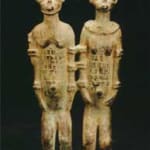Dogon Bronze Sculpture of an Ancestral Couple, 17th Century CE - 19th Century CE
Bronze
2.375 x 4.875
PF.5265 (LSO)
This elegant depiction of an elongated couple standing arm-to-arm was made by the Dogon group. They are male and female, representing the primordial couple that is fundamental to Dogon religious...
This elegant depiction of an elongated couple standing arm-to-arm was made by the Dogon group. They are male and female, representing the primordial couple that is fundamental to Dogon religious belief. They are traditional in some respects – namely the short, flexed legs, the long trunks and the bracelets on wrists and arms – but are unusually rendered in the wall-like detailing of the torsos and the detailing of the faces.
The Dogon people of the Bandiagara escarpment, Mali, have been described as the most studied and least understood tribal group in Africa. Their culture is exceptionally complex, owing to their long history and also their internal variability along their home range. They are excessively prolific in terms of artistic production; masks/figures in stone, iron, bronze/copper and wood are all known, in addition to cave/rock painting and adaptation of more modern materials. While Islam is prominent in and around the Dogon area, they have remained defiantly figurative in their artistic expression, a tradition which of course is technically banned under Islamic law.
There are seventy-eight different mask forms still in production (and numerous extinct variants), which have applications ranging from circumcision to initiation and funeral rites (damas). The Dogon took inspiration from the Tellem (lit. “we found them”) sculptures recovered from caves on the escarpment, notably human figures with upraised arms in what is believed to be a prayer for rainfall. Most figures were not made to be seen publicly, and are commonly kept by the spiritual leader (hogon) away from the public eye, in family houses or sanctuaries. Smaller pieces such as this could have been personal, but the expense of metal and the process of casting make them elite objects.
It is not an understatement to claim that the Dogon are obsessed with their ancestors, both historical and mythical. The myth of nommo – mythical ancestor beings – is found throughout the Dogon area, although representations vary. However, couples are a common image in numerous African tribal groups, and there is evidence to suggest that the Dogon representations are directly inspired by the Djenne/Djennenke, the most ancient and important group in West Africa.
This is an impressive piece of African art.
The Dogon people of the Bandiagara escarpment, Mali, have been described as the most studied and least understood tribal group in Africa. Their culture is exceptionally complex, owing to their long history and also their internal variability along their home range. They are excessively prolific in terms of artistic production; masks/figures in stone, iron, bronze/copper and wood are all known, in addition to cave/rock painting and adaptation of more modern materials. While Islam is prominent in and around the Dogon area, they have remained defiantly figurative in their artistic expression, a tradition which of course is technically banned under Islamic law.
There are seventy-eight different mask forms still in production (and numerous extinct variants), which have applications ranging from circumcision to initiation and funeral rites (damas). The Dogon took inspiration from the Tellem (lit. “we found them”) sculptures recovered from caves on the escarpment, notably human figures with upraised arms in what is believed to be a prayer for rainfall. Most figures were not made to be seen publicly, and are commonly kept by the spiritual leader (hogon) away from the public eye, in family houses or sanctuaries. Smaller pieces such as this could have been personal, but the expense of metal and the process of casting make them elite objects.
It is not an understatement to claim that the Dogon are obsessed with their ancestors, both historical and mythical. The myth of nommo – mythical ancestor beings – is found throughout the Dogon area, although representations vary. However, couples are a common image in numerous African tribal groups, and there is evidence to suggest that the Dogon representations are directly inspired by the Djenne/Djennenke, the most ancient and important group in West Africa.
This is an impressive piece of African art.



